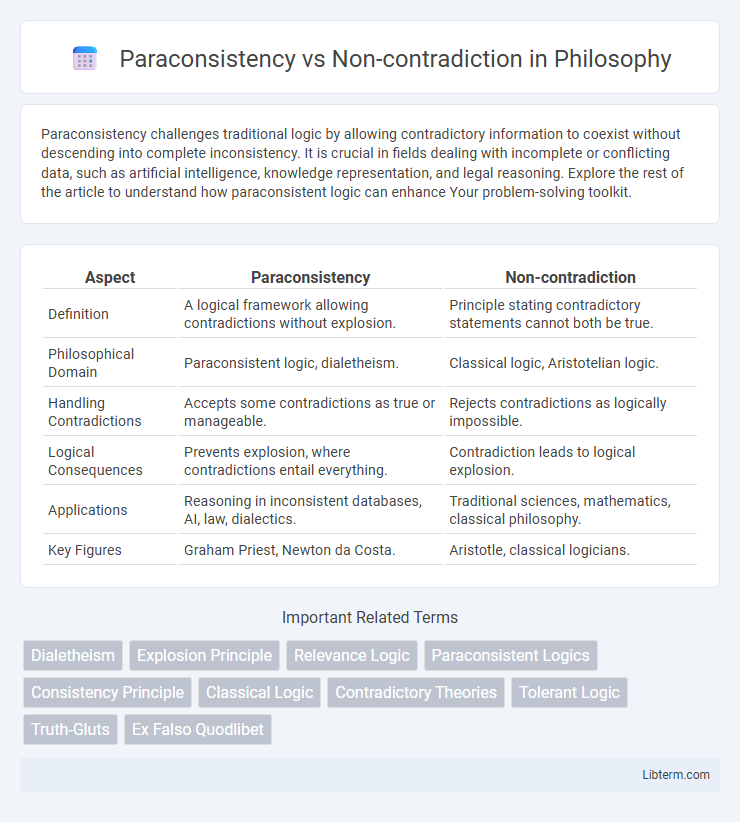Paraconsistency challenges traditional logic by allowing contradictory information to coexist without descending into complete inconsistency. It is crucial in fields dealing with incomplete or conflicting data, such as artificial intelligence, knowledge representation, and legal reasoning. Explore the rest of the article to understand how paraconsistent logic can enhance Your problem-solving toolkit.
Table of Comparison
| Aspect | Paraconsistency | Non-contradiction |
|---|---|---|
| Definition | A logical framework allowing contradictions without explosion. | Principle stating contradictory statements cannot both be true. |
| Philosophical Domain | Paraconsistent logic, dialetheism. | Classical logic, Aristotelian logic. |
| Handling Contradictions | Accepts some contradictions as true or manageable. | Rejects contradictions as logically impossible. |
| Logical Consequences | Prevents explosion, where contradictions entail everything. | Contradiction leads to logical explosion. |
| Applications | Reasoning in inconsistent databases, AI, law, dialectics. | Traditional sciences, mathematics, classical philosophy. |
| Key Figures | Graham Priest, Newton da Costa. | Aristotle, classical logicians. |
Introduction to Paraconsistency and Non-Contradiction
Paraconsistency challenges the classical principle of non-contradiction by allowing contradictory statements to coexist without leading to logical explosion. Non-contradiction, a foundational law in classical logic, asserts that a statement and its negation cannot both be true simultaneously. Paraconsistent logic provides formal systems that manage contradictions systematically, enabling reasoning in contexts where inconsistencies are present but do not render the entire system trivial.
Defining Paraconsistent Logic
Paraconsistent logic challenges the principle of non-contradiction by allowing contradictory statements to coexist without entailing triviality, meaning contradictions do not lead to every statement being true. This logic system is designed to handle inconsistent but non-trivial information, making it essential in fields like knowledge representation, artificial intelligence, and database theory. Paraconsistent logic frameworks provide formal tools to reason reliably in the presence of contradictions, unlike classical logic where contradictions collapse the entire reasoning process.
The Principle of Non-Contradiction: An Overview
The Principle of Non-Contradiction asserts that a statement and its negation cannot both be true simultaneously, forming a foundational axiom in classical logic. Paraconsistent logic challenges this by allowing contradictory statements to coexist without resulting in logical explosion, thereby accommodating inconsistent but non-trivial reasoning systems. This divergence highlights the fundamental philosophical and practical distinctions between classical and paraconsistent frameworks in handling contradictions.
Philosophical Foundations of Non-Contradiction
The principle of non-contradiction, rooted in Aristotelian logic, asserts that contradictory propositions cannot both be true simultaneously, forming a cornerstone of classical metaphysics and rational discourse. Philosophically, this principle underpins the law of identity and coherent thought, ensuring that statements maintain consistency and stability within logical systems. Paraconsistent logic challenges this foundation by allowing contradictions to be tolerated without collapse into triviality, thus redefining classical boundaries on truth and inference in philosophical and formal reasoning contexts.
How Paraconsistent Logic Addresses Contradictions
Paraconsistent logic directly tackles contradictions by allowing inconsistent information to coexist without leading to triviality, unlike classical logic which adheres strictly to the principle of non-contradiction. This logic framework enables reasoning systems to handle contradictory data by rejecting the explosion principle, where a single contradiction implies any conclusion. Paraconsistent logics find practical application in areas like knowledge representation, artificial intelligence, and information systems, where conflicting data must be processed without compromising overall system reliability.
Key Differences Between Paraconsistency and Non-Contradiction
Paraconsistency challenges the classical logic principle of non-contradiction by allowing contradictions to coexist without entailing triviality, thereby enabling reasoning in the presence of inconsistent information. Non-contradiction asserts that contradictory statements cannot both be true simultaneously, maintaining logical consistency and preventing explosive outcomes in classical logic systems. The key difference lies in paraconsistent logic's tolerance for contradictions within a controlled framework, whereas non-contradiction enforces strict binary truth values to avoid any contradiction.
Applications of Paraconsistent Logic in Practice
Paraconsistent logic, unlike classical logic which strictly adheres to the principle of non-contradiction, allows for reasoning in the presence of contradictions without trivialization. In fields such as artificial intelligence, knowledge representation, and database management, paraconsistent logic provides robust frameworks for handling inconsistent or incomplete information effectively. Practical applications include fault-tolerant systems, legal reasoning, and medical diagnosis where conflicting data must be analyzed without discarding valuable insights.
Challenges and Criticisms of Paraconsistent Approaches
Paraconsistent logic challenges the classical principle of non-contradiction by allowing contradictions to coexist without collapsing into triviality, raising issues regarding its intuitive compatibility with traditional reasoning. Critics argue that paraconsistent systems complicate inferential clarity and practical applicability, often demanding complex semantic frameworks that can hinder adoption. The principal challenge lies in balancing expressive power with consistency management, as paraconsistency risks undermining the foundational reliability expected in formal logic and computational implementations.
Historical Development and Influential Theories
The historical development of paraconsistency traces back to early 20th-century logicians like Jan Lukasiewicz and Stanislaw Jaskowski, who challenged the classical principle of non-contradiction by allowing inconsistent but non-trivial systems. Influential theories such as Graham Priest's dialetheism further advanced paraconsistent logic by accepting true contradictions, while classical logic historically upheld Aristotle's Law of Non-Contradiction as fundamental to rational discourse. The evolution of these ideas reflects a philosophical and mathematical shift from strict binary truth values towards more flexible systems accommodating inconsistency without collapse.
Future Directions in Logic: Bridging Paraconsistency and Non-Contradiction
Future directions in logic emphasize integrating paraconsistency with the classical principle of non-contradiction to develop robust reasoning systems capable of handling conflicting information without collapsing into triviality. Research explores hybrid logical frameworks and computational models that reconcile paraconsistent tolerance for contradictions with traditional consistency constraints, improving applications in artificial intelligence and formal epistemology. Advances in modal and many-valued logics aim to bridge these paradigms, enhancing conflict resolution, knowledge representation, and automated reasoning under uncertainty.
Paraconsistency Infographic

 libterm.com
libterm.com